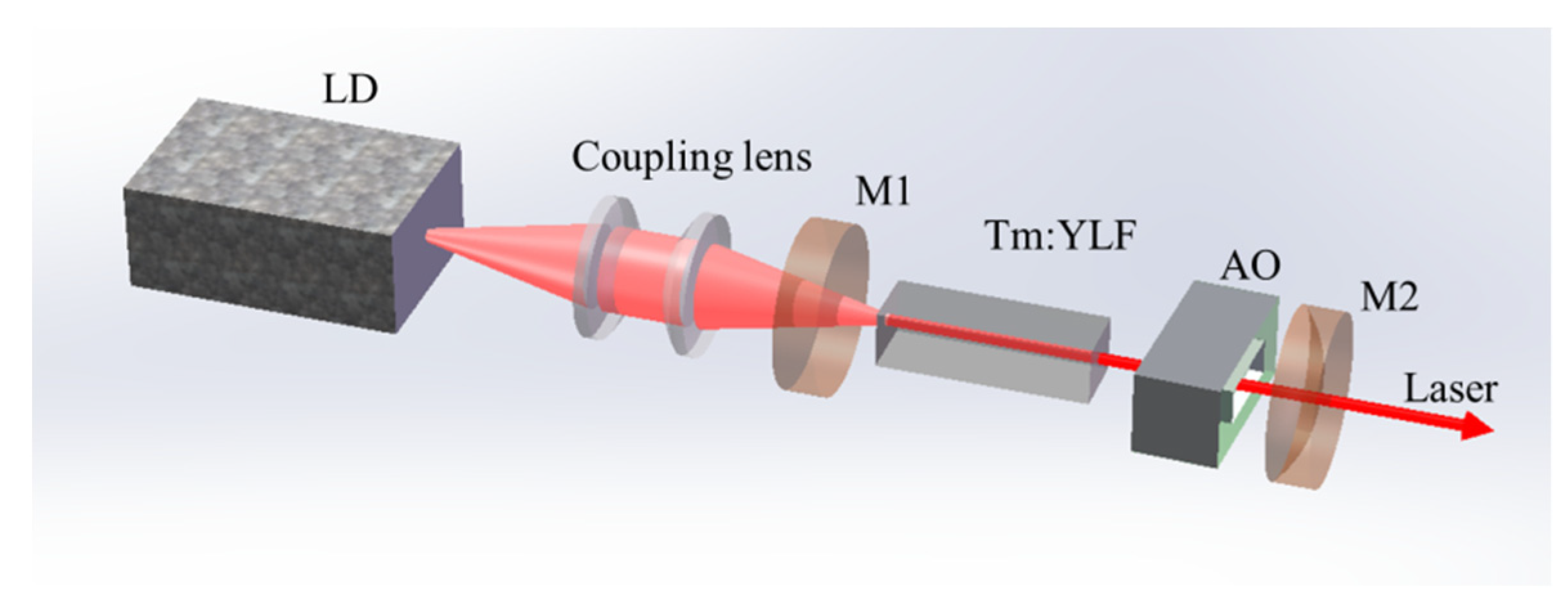Experimental and Theoretical Study of an Actively Q-Switched Tm:YLF Laser with an Acousto-Optic Modulator
Abstract
:1. Introduction
2. Experimental Setup
3. Experimental Results
4. Theoretical Analysis
5. Conclusions
Author Contributions
Funding
Institutional Review Board Statement
Informed Consent Statement
Data Availability Statement
Conflicts of Interest
Sample Availability
References
- Li, J.; Yang, S.H.; Zhang, H.Y.; Hu, D.X.; Zhao, C.M. Diode-pumped room temperature single frequency Tm: YAP laser. Laser Phys. Lett. 2010, 7, 203–205. [Google Scholar] [CrossRef]
- Li, G.; Yao, B.Q.; Meng, P.B.; Ju, Y.L.; Wang, Y.Z. Efficient continuous wave and Q-switched operation of a dual-end pumped c-cut Tm: YAP laser. Laser Phys. 2010, 20, 1871–1876. [Google Scholar] [CrossRef]
- Yumoto, M.; Saito, N.; Urata, Y.; Wada, S. 128 mJ/Pulse, Laser-Diode-Pumped, Q-Switched Tm: YAG Laser. IEEE J. Sel. Top. Quant. 2014, 21, 364–368. [Google Scholar] [CrossRef]
- Luan, C.; Yang, K.J.; Zhao, J.; Zhao, S.Z.; Qiao, W.C.; Li, T.; Feng, T.L.; Liu, C.; Qiao, J.P.; Zheng, L.H.; et al. Dual-loss-modulated Q-switched Tm:LuAG laser with AOM and monolayer grapheme. Appl. Opt. 2015, 54, 8024–8029. [Google Scholar] [CrossRef] [PubMed]
- Shen, Y.J.; Duan, X.M.; Yuan, J.H.; Dai, T.Y.; Yao, B.Q.; Wang, Y.Z. Investigation of high-power diode-end-pumped Tm: YLF laser in slab geometry. Appl. Opt. 2015, 54, 1958–1962. [Google Scholar] [CrossRef] [PubMed]
- Jabczyński, J.K.; Gorajek, L.; Zendzian, W.; Kwiatkowski, J.; Jelinkova, H.; Sulc, J.; Nemec, M. Efficient, high peak power, Q-switched, tunable, diode pumped Tm:YLF laser. Solid State Lasers Amplif. III 2008, 6998, 69980C. [Google Scholar]
- Korenfeld, A.; Sebbag, D.; Ami, U.B.; Shalom, E.; Marcus, G.; Noach, S. High pulse energy passive Q-switching of a diode-pumped Tm:YLF laser by Cr:ZnSe. Laser Phys. Lett. 2015, 12, 045804. [Google Scholar] [CrossRef]
- Sheintop, U.; Perez, E.; Sebbag, D.; Komm, P.; Marcus, G.; Noach, S. Actively Q-switched tunable narrow bandwidth milli-Joule level Tm:YLF laser. Opt. Express 2018, 26, 22135–22143. [Google Scholar] [CrossRef] [PubMed]
- Yao, B.Q.; Meng, P.B.; Li, G.; Ju, Y.L.; Wang, Y.Z. Comparison of Tm: YLF and Tm: YAP in thermal analysis and laser performance. JOAS B 2011, 28, 1866–1873. [Google Scholar] [CrossRef]
- Yasukevich, A.S.; Loiko, P.; Gusakova, N.V.; Serres, J.M.; Mateos, X.; Yumashev, K.V.; Kuleshov, N.V.; Petrov, V.; Griebner, U.; Aguiló, M.; et al. Modelling of graphene Q-switched Tm lasers. Opt. Commun. 2017, 389, 15–22. [Google Scholar] [CrossRef]
- Rustad, G.; Stenersen, K. Modeling of laser-pumped Tm and Ho lasers accounting for upconversion and ground-state depletion. IEEE J. Quantum Electron. 1996, 32, 1645–1656. [Google Scholar] [CrossRef]
- Li, G.; Liu, H.J.; Lu, F.; Wen, X.L.; Gu, Y.Q.; Wang, Y.Z. Analysis on preferential free running laser wavelength and performance modeling of Tm3+-doped YAP and YLF. Appl. Opt. 2014, 53, 4987–4996. [Google Scholar] [CrossRef] [PubMed]
- Walsh, B.M.; Barnes, N.P.; Bartolo, B.D. Branching ratios, cross sections, and radiative lifetimes of rare earth ions in solids: Application to Tm3+ and Ho3+ ions in LiYF4. J. Appl. Phys. 1998, 83, 2772–2787. [Google Scholar] [CrossRef]
- Xiao, Y.; Kuang, X.Y.; Yeung, Y.Y.; Ju, M. Investigation of the Structure and Luminescence Mechanism of Tm3+-Doped LiYF4: New Theoretical Perspectives. Inorg. Chem. 2020, 59, 1211–1217. [Google Scholar] [CrossRef] [PubMed]
- Budni, P.A.; Lemons, M.L.; Mosto, J.R.; Chicklis, E.P. High-power/high-brightness diode-pumped 1.9-μm thulium and resonantly pumped 2.1-μm holmium lasers. IEEE J. Sel. Top. Quant. 2000, 6, 629–635. [Google Scholar] [CrossRef]
- Evans, C.A.; Ikonic, Z.; Richards, B.; Harrison, P.; Jha, A. Theoretical modeling of a ~2 μm Tm3+-doped tellurite fiber laser: The influence of cross relaxation. J. Lightwave Technol. 2009, 27, 4026–4032. [Google Scholar] [CrossRef]








| Parameter | Value | Parameter | Value |
|---|---|---|---|
| h | 6.625 × 10−34 J·s | lc | 70 mm |
| NTm | 4.89 × 1020 cm−3 | σe | 3 × 10−21 cm2 |
| n, n1 | 1.46, 1.44 | KCR | 8 × 10−18 cm3s−1 |
| ƒu, ƒl | 0.2916, 0.0322 | KETU1 and KETU2 | 1 × 10−19 cm3s−1 |
| τi (i = 2, 3, 4) | 15, 2.258, 0.715 ms | R | 80% |
| β43, β42, β32 | 0.1, 0.03, 0.03 | L | 1.5% |
| l, l1 | 10 mm, 5 mm | A | 0.1256 mm2 |
| Repetition Frequencies (kHz) | Pulse Durations (ns) | Pulse Energies (mJ) | Peak Power (kW) |
|---|---|---|---|
| 5 | 68 (239) | 1.46 (1.45) | 21.5 (6.1) |
| 8 | 114 (390) | 0.92 (0.92) | 8.1 (2.4) |
| 10 | 140 (491) | 0.73 (0.74) | 5.2 (1.5) |
Publisher’s Note: MDPI stays neutral with regard to jurisdictional claims in published maps and institutional affiliations. |
© 2021 by the authors. Licensee MDPI, Basel, Switzerland. This article is an open access article distributed under the terms and conditions of the Creative Commons Attribution (CC BY) license (https://creativecommons.org/licenses/by/4.0/).
Share and Cite
Guo, L.; Yang, Y.; Wang, R.; Zhang, B.; Li, T.; Zhao, S.; He, J.; Yang, K. Experimental and Theoretical Study of an Actively Q-Switched Tm:YLF Laser with an Acousto-Optic Modulator. Molecules 2021, 26, 7324. https://doi.org/10.3390/molecules26237324
Guo L, Yang Y, Wang R, Zhang B, Li T, Zhao S, He J, Yang K. Experimental and Theoretical Study of an Actively Q-Switched Tm:YLF Laser with an Acousto-Optic Modulator. Molecules. 2021; 26(23):7324. https://doi.org/10.3390/molecules26237324
Chicago/Turabian StyleGuo, Lei, Yaling Yang, Ruihua Wang, Baitao Zhang, Tao Li, Shengzhi Zhao, Jingliang He, and Kejian Yang. 2021. "Experimental and Theoretical Study of an Actively Q-Switched Tm:YLF Laser with an Acousto-Optic Modulator" Molecules 26, no. 23: 7324. https://doi.org/10.3390/molecules26237324
APA StyleGuo, L., Yang, Y., Wang, R., Zhang, B., Li, T., Zhao, S., He, J., & Yang, K. (2021). Experimental and Theoretical Study of an Actively Q-Switched Tm:YLF Laser with an Acousto-Optic Modulator. Molecules, 26(23), 7324. https://doi.org/10.3390/molecules26237324







